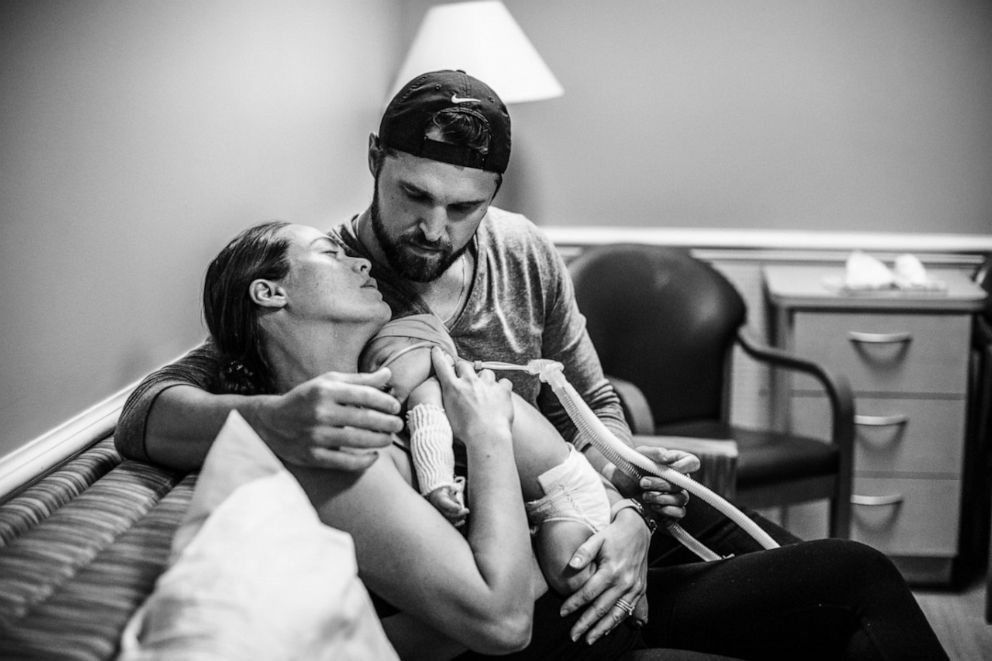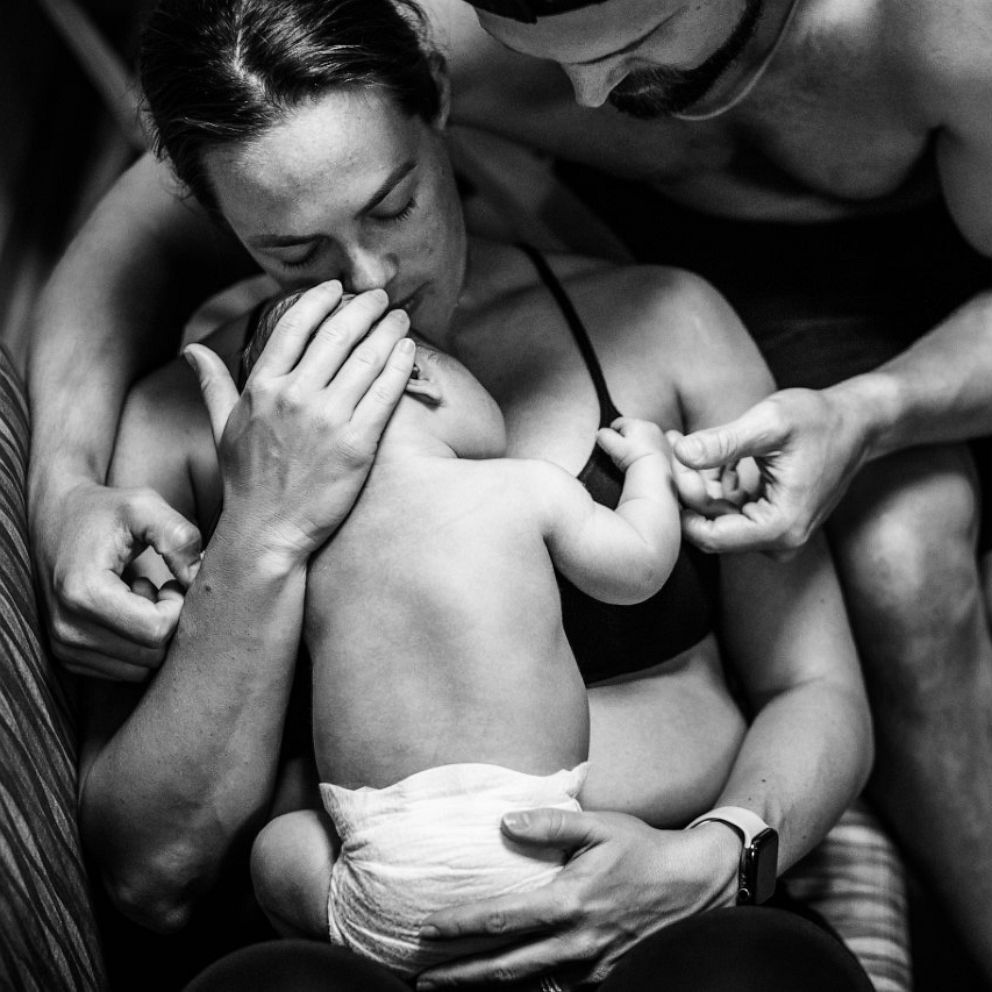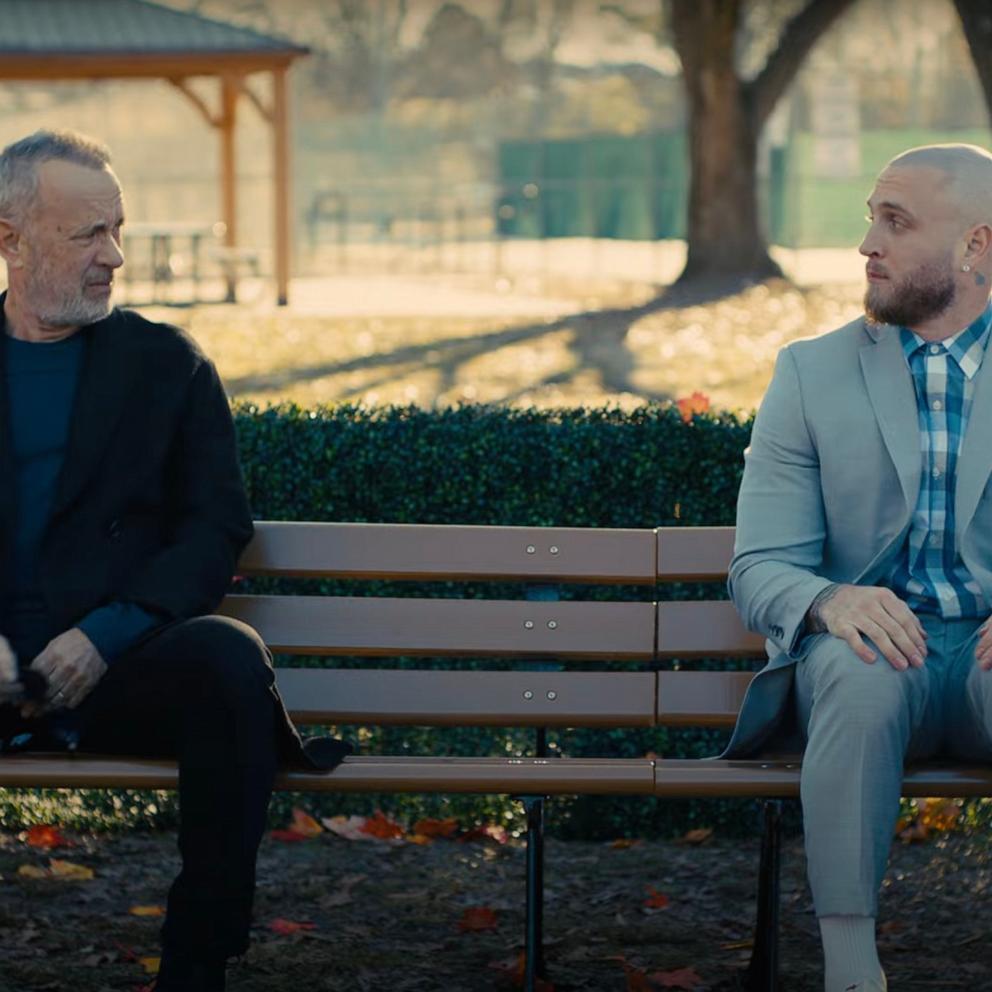'Real Housewives' star Kara Keough Bosworth opens up about the heartbreaking loss of her newborn son
Over the past month, "Real Housewives of Orange County" star Kara Keough Bosworth has been keeping track of the milestones her son would have hit had he not died April 12, six days after he was born. She wonders what life would look like. What would he be doing?
McCoy Casey Bosworth experienced shoulder dystocia and a compressed umbilical cord during his birth, and days later, his parents received the prognosis they feared most: he’d suffered severe brain damage and was unlikely to recover.
“I've been lucky to hear from parents that are on the other side of it, or as far on the other side as you can be, and they say it gets better,” Bosworth told “Good Morning America” in her first interview since the tragedy. “They say eventually the waves of grief don't feel like they're knocking you over every day, and that you have to just get through it -- but that you aren't alone.”
“We had a strong son and he fought every second of his life,” added her husband, former professional football player Kyle Bosworth. “Now we’ve got to figure out how to make his life meaningful.”
Inside the ‘Olympic effort’ to deliver her baby
Bosworth, 31, wanted her second pregnancy to be different than the one she had with her 4-year-old daughter, Decker. For starters, she and her husband, 33, opted not to find out the baby’s sex ahead of time, and picked a name that would work no matter what: McCoy Casey.
"If it was a girl, we were gonna call her Mickey and a boy, we were gonna call him Mack,” Bosworth, who works in content marketing, said. “We were all joking, 'Maybe when you're big someday, you'll be like, 'Mack Truck,' and that'll be a sports nickname.’” Kyle, who co-owns a real estate firm, came up with Casey, which incorporates the letters of his and Bosworth’s siblings’ names.
But the biggest change this time around was Bosworth’s birth plan. She had to be induced with Decker after her water broke two weeks early, and asked for an epidural. For this delivery, Bosworth said she was “pretty committed to an unmedicated birth … to see what the female body is capable of.”
When the novel coronavirus pandemic hit, Bosworth decided against a hospital birth. Instead, she chose to deliver with the support of a licensed nurse-midwife at her home in Jacksonville, Florida.
According to a 2016 report from the American College of Obstetricians and Gynecologists, there are approximately 35,000 home births in the U.S. each year. But, leading medical associations have not recommended home births, citing statistics that newborns are twice as likely to die in that scenario. Hospitals, by contrast, are prepared for emergencies with additional professional staff and medical technology.
ACOG, the American College of Nurse-Midwives, American Academy of Family Physicians, and Society for Maternal-Fetal Medicine issued a joint statement in March that "hospitals and birth centers that are both licensed and accredited remain safe places to give birth in the United States," though they acknowledge any woman's right to choose where she delivers. This policy is upheld by these organizations today.
Just a few days after her due date, Bosworth's water broke late at night; she was sitting on the couch and heard what sounded like the snap of a rubber band before she felt anything. Bosworth hurried upstairs and remembers telling Kyle to fill the birthing tub in their bedroom. They lit candles and put on the playlist they’d made for the occasion, and Kyle dutifully applied counter-pressure to Bosworth’s back during contractions. Her labor with Decker was short, and Bosworth’s obstetrician had warned her that for most women, second births progress more quickly. Sure enough, within two hours, she realized, “We're having a baby tonight!” Her nurse-midwife arrived at 2:30 a.m., just as Bosworth was getting the urge to push.

But in an instant, everything changed. “I pushed his head out quickly,” Bosworth recalled, but his body didn’t follow. She knew immediately that McCoy was stuck -- a frightening condition known as shoulder dystocia.
Her midwife's assistant called 911 right away. For the next nine minutes, Bosworth went into “fight mode” as she and her birthing team -- her husband, her nurse-midwife, her midwife's assistant, and a doula -- put forth an "Olympic effort" to deliver her son. Her midwife cycled through various maneuvers, as Bosworth, who was "literally begging God to save my baby," contorted her body. An emergency medical team walked in just as McCoy was born.
The first time Bosworth laid eyes on McCoy, he was face down. She turned him over and told her husband, "Babe, it's a boy!" before it registered that she hadn’t heard the baby cry. McCoy wasn't breathing or moving.
As first responders delivered chest compressions to her 11-pound, 4-ounce baby, all Bosworth could do was stare, in shock.
What is shoulder dystocia and the risks of home births
Shoulder dystocia is an unpredictable, unpreventable obstetric emergency that happens when one or both of a baby's shoulders gets caught in a mother's pelvis during delivery, according to ACOG. The condition is rare, occurring in just .2 to 3% of pregnancies, the organization reported, and in most cases, babies survive.
Shoulder dystocia is the terrifying factor for an OB. They’re very traumatic.
“Shoulder dystocia is the terrifying factor for an OB. They’re very traumatic for the mother, the baby, and the doctor,” said Dr. Jacques Moritz, a New York City OB-GYN and the medical director of Tia Women's Health, who has no connection to Bosworth’s case. “It is [one of the reasons] why you need a trained person to deliver a baby.”
Although shoulder dystocia can happen in any setting, many experts believe it is more effectively treated in a hospital.
“It’s not so much the maneuvers as, ‘How well are you optimizing each one?’” said Dr. Jessica Shepherd, a Chicago OB-GYN and founder of Her Viewpoint, an online women’s health forum, who also has no connection to Bosworth. “We could call 20 people in the room -- people trained to do things like positioning [of the mother].”
"Obstetricians in the United States are concerned about home births because we don’t have a rigorous system in place where if things start to become abnormal, we have an easy and safe way to transfer women to the hospital," added Dr. Elizabeth Langen, an OB-GYN and clinical associate professor at the University of Michigan who also did not treat Bosworth. "Results for home births in the U.S. are not the same as they are in other countries."
Michelle Palmer, a certified nurse-midwife in Hope, Rhode Island and the chair of ACNM's Home and Birth Center Committee, said that a woman interested in home birth discusses potential complications with her nurse-midwife from the start. She was not involved with Bosworth’s delivery.
"We have informed consent decision-making about choosing this setting," she said.
Inside her decision to deliver at home
Until the very end of her pregnancy, Bosworth planned to deliver at a hospital.
There is no evidence of an increased risk of contracting the virus in the delivery room, but as COVID-19 fears consumed the U.S., Bosworth says her anxiety took over. Her hospital limited the number of people she could have in the delivery room, and while she was grateful that her husband would be able to be there, she said she couldn't fathom giving birth without the support of her doula.
Bosworth decided that a home birth made the most sense for her family. A midwife was going to deliver the baby anyway, she reasoned, and she'd planned to avoid medical interventions if she could. A close friend had given birth to twins at home, and raved about the experience, Bosworth said.
"Part of my decision-making was, 'Well, if there's a need for me to transfer, I'm four blocks from a hospital and my midwives are trained to know when that point is that they can no longer have the birth successfully at home,” she added.
She's not alone. As COVID-19 rages on, interest in home births has spiked, Palmer said. However, the pandemic has presented new risks for women delivering at home, according to some experts.
"If you're at home, our first responders in many areas are way overburdened and may be delayed in getting to you, and if you get to the hospital in an emergency you may go through the ER, which has a higher risk for infections," said neonatologist Kristi Watterberg, a professor of pediatrics at the University of New Mexico and former chair of the American Academy of Pediatrics' Committee on the Fetus and Newborn.
'How do you hide an 11-pound baby?'
Among the risk factors for shoulder dystocia is macrosomia, the medical term used to describe a much larger than average newborn. McCoy weighed 11 pounds, 4 ounces at birth -- about 3 1/2 pounds above average, according to figures provided by ACOG. At least 50% of deliveries with shoulder dystocia have no identifiable risk factors.
Throughout her pregnancy, Bosworth said a team of obstetricians and midwives coordinated her care. At her 20-week scan, nothing seemed amiss, she said, so no follow-up ultrasound appointment was made, in keeping with guidelines put forth by ACOG.
“When you think of third trimester ultrasounds, you have a bigger baby in a smaller space. They typically tend to contort themselves really well and it’s hard to get accurate measurements,” Shepherd explained. “The way we constitute a weight is we take bone lengths, the circumference of the abdomen and the head, and figure out collectively, what does an estimated fetal weight look like? It’s so much harder when you’re not getting the most accurate measurements.”
Bosworth's fundal height was always right on track, and her weight gain remained within the recommended range for a woman her size. So, at her 38-week appointment, Bosworth confirmed with her doctor that the baby was in a good position for birth. Then, she went home and waited.
When McCoy was born, Bosworth said she and her medical team were stunned to learn how big he was.
"How do you hide an 11-pound baby?" she recalled asking herself.
"I will sit here and regret not getting [another ultrasound] for the rest of my life, because I'll think, 'Maybe we would've known. Maybe they would've seen that he had 7 1/2-inch shoulders,'" she said. "But that's just going to be [in] my head."
Meeting their son and saying goodbye
Bosworth stayed behind after McCoy's birth to deliver her placenta as first responders rushed the baby to the hospital. At Bosworth's urging, Kyle followed behind the ambulance. After 45 minutes of chest compressions, with his father by his side, McCoy’s heart began to beat again.
He came back to fight, to see if he could live, and it was a miracle.
“It seemed like an eternity,” Kyle recalled. “But he came back to fight, to see if he could live, and it was a miracle.”
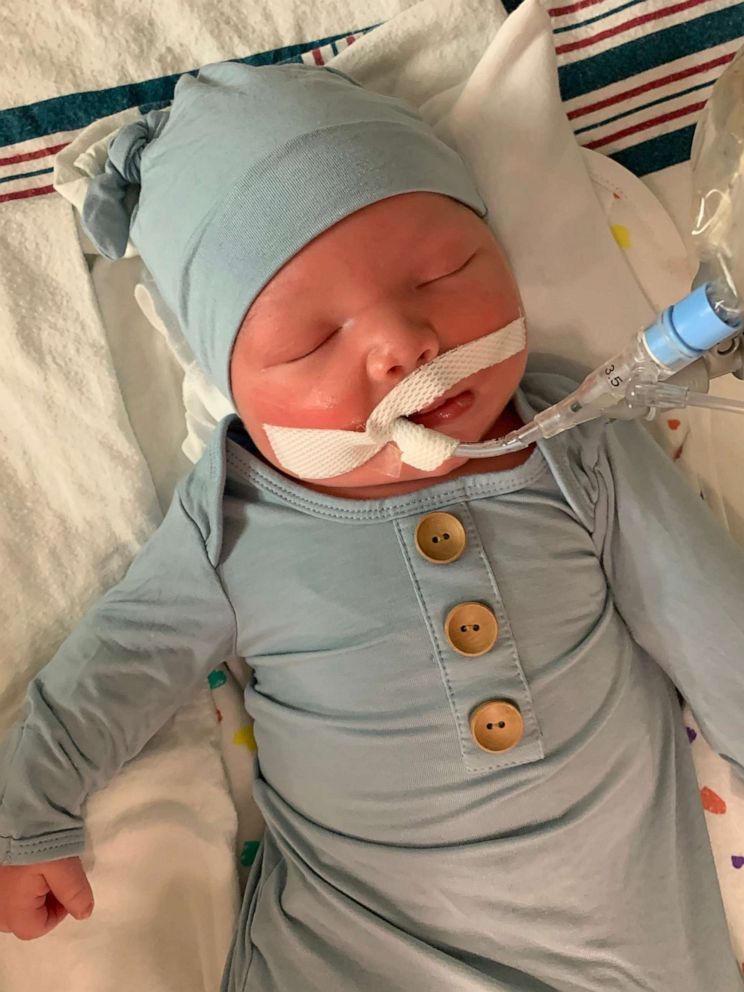
From the beginning, though, doctors had warned that McCoy’s brain activity was “extremely suppressed,” Kyle said.
“They were telling us that they were trying to prevent further brain injury, but the baseline wasn’t good,” he said. “There was severe trauma.”
“They used the word ‘grim’ a lot,” added Bosworth.
Physicians told the Bosworths that after 72 hours, they would do an MRI to get a more complete read of McCoy’s brain activity. In the meantime, the new parents spent as much time as they could with their baby, taking turns because of COVID-19 restrictions.
"I'd go pump in the waiting room while he would be with him,” Bosworth said. "Then he would let me go in there and sing to him and tell him all the things he’d done while he was in my belly and kind of get to know him.”
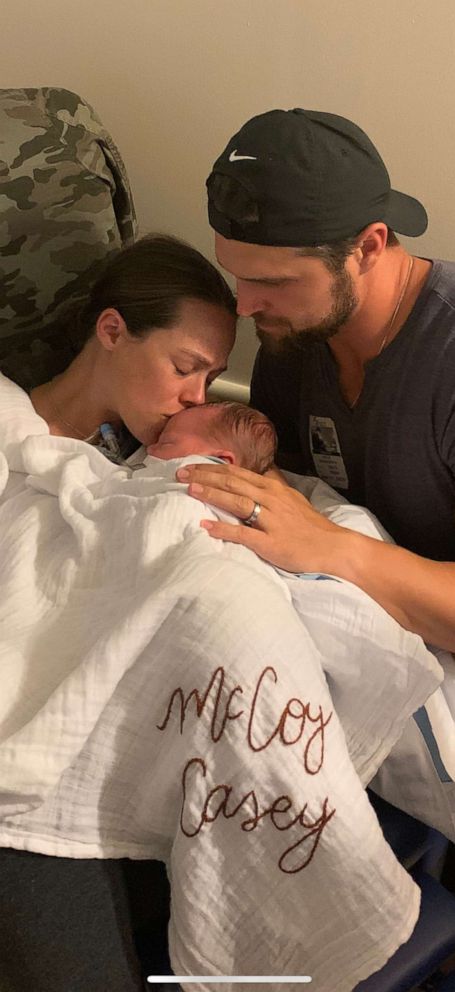
But after it became clear that McCoy was not going to go home, “they made an exception to let us both be by his side,” Bosworth said. They also let his big sister Decker visit.
"She got to sing to him and play 'This Little Piggy' on his fingers," Bosworth recalled. "She was very happy to tell the nurses his 'full big name,' as she called it."
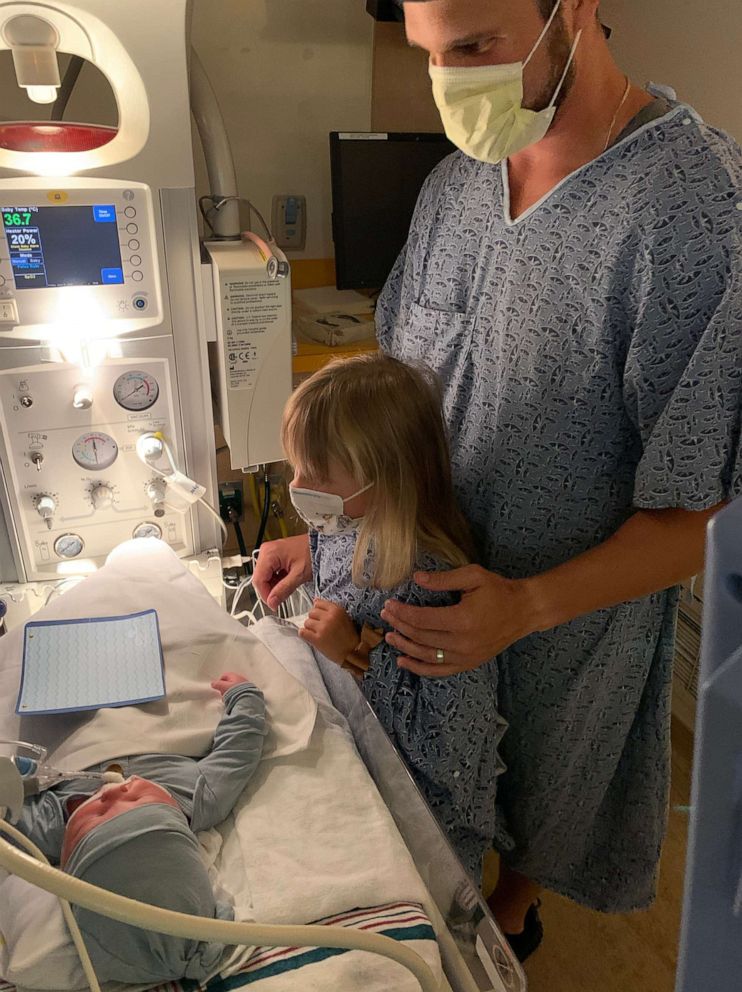
The Bosworths savored every moment they had with their son. "We got some milestones we didn't think we'd get, “ Bosworth said. “We got to change his diaper. I got to get peed on, which is a boy-mom thing I didn't think I'd ever get. We got to hold him, we got to feel warmth in his body."
Moving forward and trying to heal
A full-term loss is a specific, hellish type of grief, Bosworth said. “It’s this weird middle ground between losing a child during pregnancy and then losing a child that you have gotten to know,” she noted.
The physical reminders of their loss, she said, only amplify the pain. “As a mom, you’re dealing with the very real repercussions of the postpartum body," she said. "I still have the pain of my milk coming in. I’m having to wrap my breasts to stop milk production. I’m still bleeding. All the unsightly, unpleasant things of having a baby, without the prize of having a baby.”
All she and Kyle can do at this point, they said, is celebrate their son’s brief life and honor his memory. After several days in the NICU, an MRI revealed that McCoy’s brain had been deprived of oxygen for too long; he had severe brain damage and was unlikely to ever gain consciousness. They removed life support on the sixth day and donated his organs. Bosworth also donated her breast milk.
"We're at that point where we just want his life to mean as much to as many people as possible," she said.
On April 21, the Bosworths launched a fundraiser for March of Dimes to "encourage birth equity among all races, and from all socioeconomic backgrounds" in Jacksonville and to help other families who have lost newborns or whose babies are in intensive care. They attend a bereaved parents group once each month and have weekly Zoom meetings with a grief counselor. Bosworth has found writing cathartic, and Kyle plans to get a tattoo -- his first ever -- of McCoy’s footprints. He said that he feels his son’s presence all the time, “hearing him in the wind and seeing him in the clouds.” To that end, loved ones have gifted them with wind chimes -- a special reminder of their little boy.

Every time McCoy takes a sprint around the block in heaven, we hear the wind chimes.
"The night he passed, there was a really, really big wind storm," Bosworth said. "Every time McCoy takes a sprint around the block in heaven, we hear the wind chimes."
Neighbors have been there for the Bosworths, too. In the days after McCoy's birth, they planted a garden and hung blue hearts in their windows to honor him.
“I truly feel we would be in a different stage mentally and physically if the support wasn’t there,” Kyle said. “We’re very lucky and blessed to have that.”
Adding to their loss, Bosworth's father, former professional baseball player Matt Keough, died from a pulmonary embolism on May 2. He was 64 years old.
"My son's spirit is somewhere with my father's spirit," Bosworth said. "They're together."
While the past few weeks have been especially hard for the Bosworths, their light has been Decker.
Throughout the ordeal, Bosworth said, Decker was aware that her brother was hurt and needed to be in the hospital. As she said goodbye to him in the NICU, Bosworth told her that it would be the last time, because he was “going to heaven.” Decker cried, her mom recalled.
But that night, before she went to sleep, Bosworth said Decker pulled her into McCoy’s nursery, and asked for another sibling. This time, Decker suggested, maybe it would be a girl. "And can you have her on Thursday?” she asked her mother. Bosworth couldn't help but laugh.
“Something that seems so horrible to me -- the idea of walking into his nursery -- she found a way to make me laugh," Bosworth said.
"It's like, 'You are such a blessing. We didn't even know how much.'"
